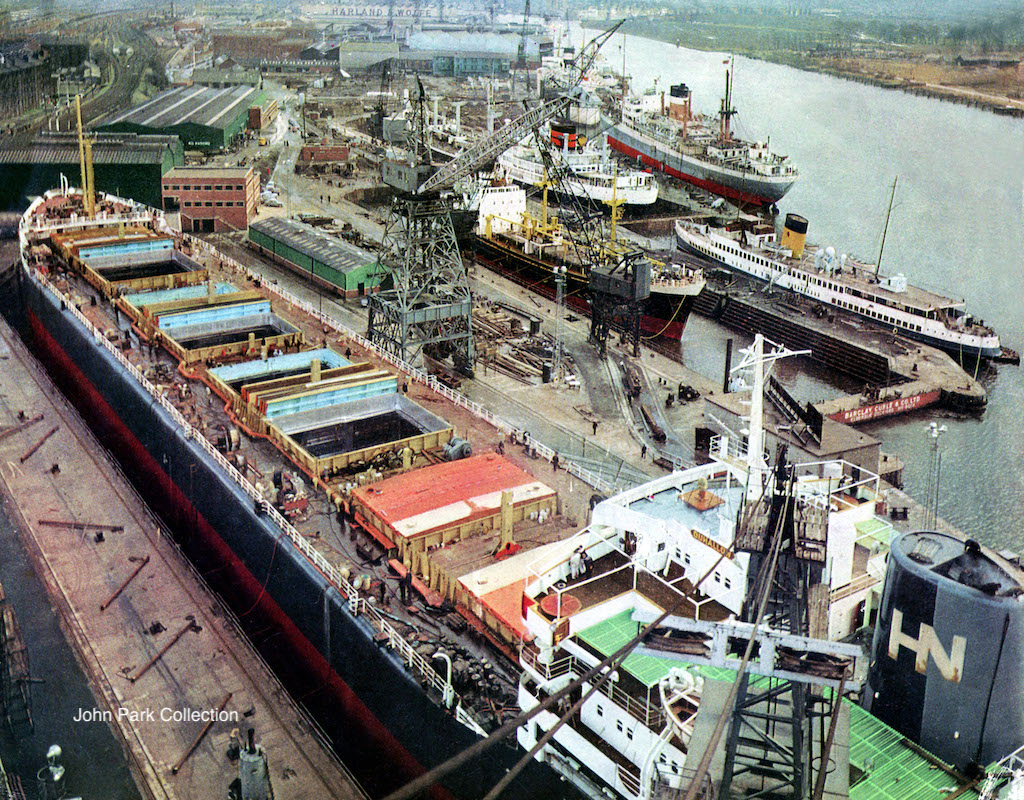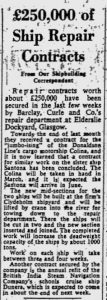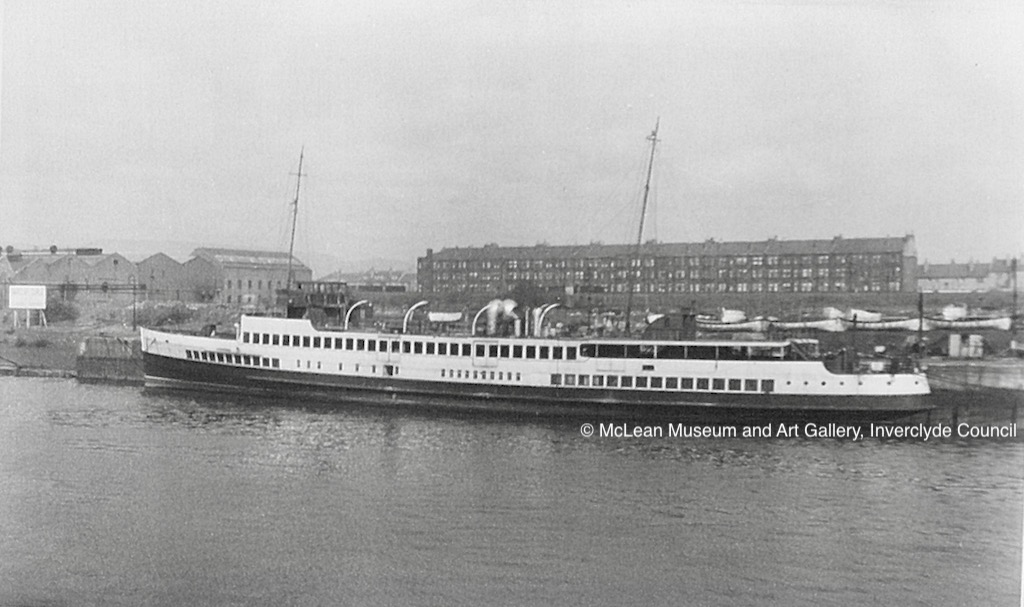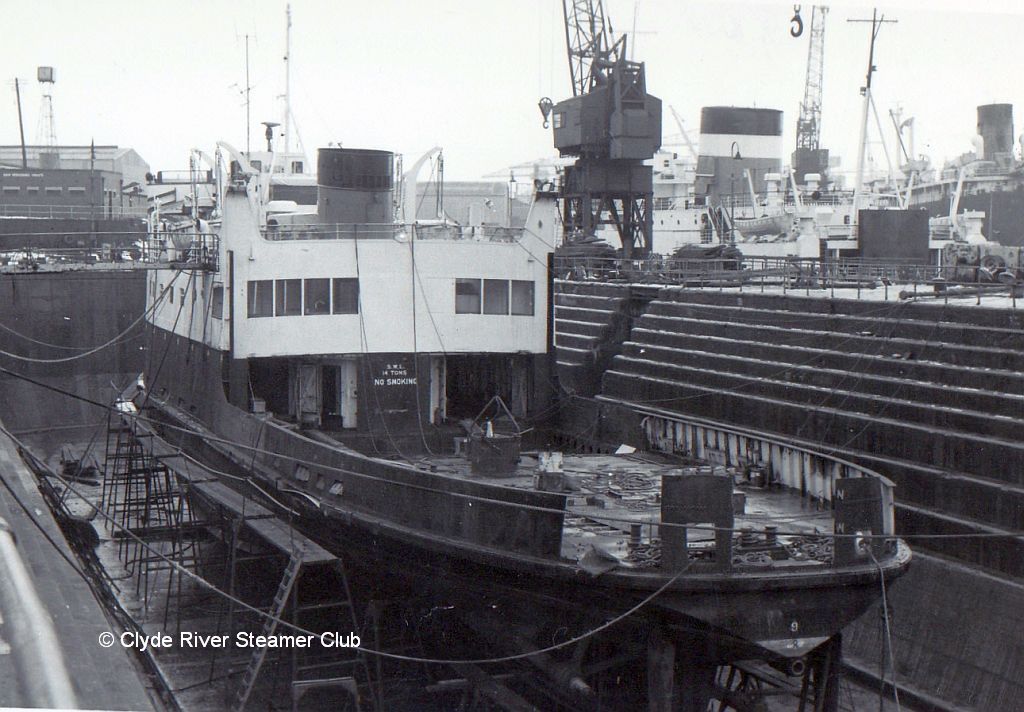
After undertaking some meticulous detective work, John Newth has managed to identify all the ships in the image posted on this site by John Park on 3 September. He has also named the exact date on which the photo was taken
Many ship enthusiasts were fascinated by a photo published on this website on 3 September, showing Queen Mary II in the late 1960s at the shipyard of Barclay, Curle & Co on the north bank of the River Clyde (above). The steamer was surrounded by a variety of other vessels, only some of which could be identified by Club member John Park, from whose collection the photo came. John was also unsure of the date of the photo.
The image piqued the interest of John Newth, whose research skills have long been evident in a number of CRSC publications, including Clyde Steamers and the annual Review, which he compiled for many years. John here presents the results of what is surely a bravura piece of investigative work, which has enabled him not only to identify every ship in the photo, but also to establish ‘almost certainly’ the day on which it was taken.
The picture published on 3 September, with Queen Mary II alongside one of Barclay, Curle and Co’s riverside berths, showed a varied selection of ships at the Elderslie yard undergoing a wide range of repairs and other work.
The three graving docks had an interesting history: No 1 (in the centre) dated from the early years of the 20th century, having been built by John Shearer and Sons, who operated on the site at that time. It was taken over by Barclay, Curle in 1912, as they expanded their business. Twenty years later a second dry dock (No 2) was built to increase capacity.

The Glasgow Herald report of 12 February 1966 announcing the Elderslie Dockyard contract for ‘jumbo-ising’ the Donaldson Line’s cargo ship Colina
The third dry dock (No 3), closest to the photographer, had only recently been built, at a cost of almost £1m. It opened at the very end of 1965 and allowed the yard to pursue additional repair work. Its construction had involved the removal of some 200,000 tons of rock and earth, and the pouring of around 100,000 tons of concrete. The two cranes servicing the new dock’s needs had come from Dumbarton, acquired from the defunct Denny shipyard and refurbished for their new role at Elderslie.
Starting with the presence of Queen Mary II, the dates for launch and completion of the Hain-Nourse bulk carrier Duhallow and reference to the daily lists of shipping movements published by the Glasgow Herald, it has been possible to establish the identity of each vessel pictured, and work out exactly when the scene was captured.
Nearest the camera is Duhallow, being prepared for her first trip out to sea. She had been launched at the Fairfield shipyard further upriver on 26 October 1965, and moved to Elderslie on 7 March. She left No 3 dry dock on the 12th, heading downstream the next day to begin four days of trials. Her overall length of 675 feet and beam of 90 feet meant that she was only just able to fit in the new dry dock, which measured 680 feet by 95 feet, leaving little room for error!
Next to her, the small Donaldson Line cargo ship Colina had only just entered the dock, which was still to be pumped dry. High tide was at 2.20pm that afternoon, and it is likely that Queen Mary II had occupied this dock immediately before. Somewhat unusually Colina was berthed stern first in the dock, and a little further research revealed the reason.
Prior to her arrival on the Clyde from the Great Lakes, Barclay, Curle and Co had been awarded contracts to build new mid-sections for her and her sister, Santona. Once in dry dock, Colina would be cut in half. Then the dock would be flooded again, her fore end floated out, the new section moved into the dry dock, the bow brought back in and, after the dock had been pumped out again, the three sections joined up. The newly lengthened Colina moved out of dry dock on 6 April. Fifteen days later she set off on her next voyage across the Atlantic to Montreal.
As already suggested by John Park in his article of 3 September, lying ahead of Queen Mary II in No 2 dry dock is the Clan Line ship Clan Grant, which, after discharging her cargo from Tasmania at King George V Dock, had arrived at the yard on 4 March. She was just one of several members of the Clan Line fleet to use the yard that spring for survey and repairs. Two weeks later she left the Clyde and headed off on another liner run to Ceylon (as Sri Lanka was then known), India and Pakistan.
Alongside the Elderslie Wall is the Ellerman City Line ship City of Oxford, a turbine steamer built at Clydebank in 1948 and which had earlier been in No 2 dry dock. Information gleaned from reports in the press suggests her visit to the yard was relatively lengthy, so must have involved a fair bit of work on board.
In front of her lies the British India Steam Navigation Company’s educational cruise ship Dunera, which had arrived from Falmouth on 18 February and would later take her place in No 2 dry dock once Clan Grant left the yard.
Finally, and only barely visible beyond Dunera, at Yarrow’s shipyard lies the Royal Navy survey vessel HMS Hydra. She was in the final stages of her outfitting, and would be commissioned a couple of months later.
Assuming, then, that the intrepid photographer – who clearly had a good head for heights as he had worked his way out to the end of the jib of the dockyard crane – took the picture on the day that Colina entered the dry dock, the picture almost certainly dates from Wednesday 9 March 1966.
If such a vantage point was still available today, the view would be much altered. While all the docks have continued in use under BAE Systems, the adjacent Yarrow shipyard has greatly expanded over the years and the types of vessel seen there nowadays are very different.
Another shipping event was also taking place that day, which perhaps attracted a larger crowd: on the same afternoon tide the original Cunard Queen Elizabeth left dry dock at Inchgreen on the south bank of the river after her major refit. That, however, is another story.
All photographs on the CRSC website are protected by copyright law. Do not reproduce them on Facebook, Pinterest or any other public platform.
QUEEN MARY II AT ELDERSLIE

The 1966 visit to Elderslie by Queen Mary II was by no means her first. In 1957 she was re-boilered by Barclay, Curle & Co, a move that led to a radical change in her appearance: she received one modern funnel instead of the original two. The turbine is pictured at Elderslie (above) on 16 February 1957 after the removal of the twin funnels which had served her since her debut in 1933. Photo from the Geoffrey Grimshaw Collection, reproduced by courtesy of the McLean Museum and Art Gallery, Greenock, which owns the copyright

This photo, again at Barclay, Curle’s Elderslie yard, dates from nearly two months later — 6 April 1957 — shortly before Queen Mary II’s substantial new single funnel was fitted in place of the original slim pair. Photo from the Geoffrey Grimshaw Collection, reproduced by courtesy of the McLean Museum and Art Gallery, Greenock, which owns the copyright
TWO FUNNELS OR ONE: WHICH SUITS HER BEST?

Queen Mary II at Bridge Wharf, Glasgow, in 1956, the summer before she lost her original twin funnels and gained a single, substantial new one

Queen Mary II at Bridge Wharf, Glasgow, in 1957, shortly after she was re-boilered and re-funnelled. There is an ongoing and fiercely contested debate in the wider enthusiast community as to whether the vessel, currently under conversion to a static role, should be preserved with two funnels or one
MV ARRAN AT BARCLAY, CURLE

CalMac car ferry Arran, built as a side-loader for the CSP in 1953, is pictured on 18 February 1973 in No 1 dry dock at Elderslie, during her conversion to stern-loading. Bardic Ferry of the Transport Ferry Service is in No 2 dry dock. Like Queen Mary II, both were Denny-built ships
With thanks to John Newth, John Park, Rob Beale, Craig Osborne and Val Boa.
Have you joined CRSC? Click here for your £10 membership and take advantage of all the benefits.
Published on 17 September 2020











